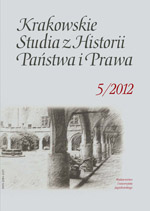Prawodawstwo sejmowe i królewskie za panowania Stefana Batorego (1576–1586). Autoreferat z obrony pracy doktorskiej, Kraków, 28 lutego 2011 r.
The legislation as adopted by the Seym and by the King under the reign of Stephen Batory (1576–1586).
Author(s): Anna KarabowiczSubject(s): Law, Constitution, Jurisprudence
Published by: Wydawnictwo Uniwersytetu Jagiellońskiego
Keywords: Stephen Batory; the legislation; the history of Polish parliamentarism; legislation
Summary/Abstract: The legislation as adopted by the Seym and by the King under the reign of Stephen Batory (1576–1586). The authoress’ own report delivered by her on occasion of her defence of doctoral thesis, Kraków 28 February 2011. Stephen Batory ruled the Republic of the Two Nations for almost 11 years. The time of his reign was characterized by specifi c relationships between him and the Polish-Lithuanian General Seym. What was reflective of this specifi cacy were the Seym proceeding practices and the nature of the law-creating process. Since the reign of king Batory was short it is not easy to formulate the rules along which the aforementioned relationships developed. The criterion that allowed to classify the major legislative acts produced at that time was that of who produced them (the criterion of the Legislator). Other criterion – for instance the traditional one based on the scope of legislative competence of the Seym and the king – would not be possible to apply. The point was that the division of matters into those left for the legislation as made by the king and those left for the legislative activities of the Seym was not dichotomous. In producing legal norms the two entities complemented each other. At the same time they also competed with each other. As a result two interesting phenomena were observable: the interchangeability of the two law-creating agencies, i.e. that of the king and that of the Seym, and also the fl exibility of the forms assumed by the legislative acts. In the discussed period the legal norms of universally binding force were adopted at the central level either in the form of resolution as made by the General Seym or in the form of acts issued by the king. The act that was expected to be considered the legislative product of the Seym was the one which jointly fulfi lled two requirements. First, it had to be produced at the time and in the place of the Seym debates (therefore in most cases, although not always, there was made in it the allusion of the type: “at the General Seym”, in conventu generalis Regni nostri). The second thing, and simultaneously the most important one, was the information that was placed in the text of the act (unless the tenor of the information could be seen from the content of the act in an obvious way) that the act was produced “while following the advice of our Lords Counsellors and with the consent given by the Seym deputies representing the provinces (de consilio consiliariorum Nostrorum, consensusque omnium ordinum)”. Other legislative acts were qualifi ed as royal acts but the latter were not homogeneous. Thus the monarch could by himself produce universals (these were his own acts).
Journal: Krakowskie Studia z Historii Państwa i Prawa
- Issue Year: 5/2012
- Issue No: 1
- Page Range: 121-132
- Page Count: 12
- Language: Polish

